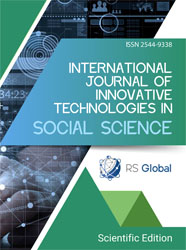DIGITAL HEALTH SOLUTIONS IN ATRIAL FIBRILLATION MANAGEMENT: ENHANCING DETECTION, MONITORING, AND PATIENT OUTCOMES
Abstract
Introduction and Objective: Atrial fibrillation (AF) is a prevalent cardiac arrhythmia associated with significant morbidity and mortality. Rapid advances in artificial intelligence (AI), wearable devices, and mobile health (mHealth) technologies hold promise to improve AF risk prediction, diagnosis, and patient management. This narrative review aims to synthesize current evidence on the integration of these innovative tools in AF care, with a focus on technological capabilities, patient engagement, and public health implications.
Review Methods: A narrative review was conducted, analyzing peer-reviewed articles, clinical trials, and authoritative reports published between 2014 and 2023. Sources were identified through comprehensive database searches using keywords related to AF, AI, digital health, and health equity. The review integrates interdisciplinary insights from cardiology, digital technology, and public health literature.
State of Knowledge: Recent studies demonstrate that AI algorithms applied to electrocardiograms (ECGs) and wearable sensor data can enhance early detection and risk stratification of AF. Mobile health tools foster patient engagement and improve self-management through real-time monitoring and education. However, challenges remain related to data privacy, algorithmic bias, and equitable access to these technologies. Public health strategies must consider social determinants of health to maximize benefits and reduce disparities in AF outcomes.
Conclusion: Innovative digital technologies offer transformative potential in AF management and public health. Future research should address existing gaps, focusing on validation in diverse populations, ethical implementation, and strategies to ensure health equity. Multidisciplinary collaboration is essential to harness these tools effectively and improve cardiovascular health outcomes globally.
References
Attia, Z. I., Noseworthy, P. A., Lopez-Jimenez, F., Asirvatham, S. J., Deshmukh, A. J., Gersh, B. J., ... & Friedman, P. A. (2019). An artificial intelligence-enabled ECG algorithm for the identification of patients with atrial fibrillation during sinus rhythm: A retrospective analysis of outcome prediction. The Lancet, 394(10201), 861–867. https://doi.org/10.1016/S0140-6736(19)31721-0
Boriani, G., Vitolo, M., Imberti, J. F., et al. (2022). Digital health tools for atrial fibrillation management: A review of current evidence and future perspectives. European Heart Journal – Digital Health, 3(1), 15–26. https://doi.org/10.1093/ehjdh/ztab098
Bumgarner, J. M., Lambert, C. T., Hussein, A. A., Cantillon, D. J., Baranowski, B., Wolski, K., ... & Lindsay, B. D. (2018). Smartwatch algorithm for automated detection of atrial fibrillation. Journal of the American College of Cardiology, 71(21), 2381–2388. https://doi.org/10.1016/j.jacc.2018.03.003
Chugh, S. S., Havmoeller, R., Narayanan, K., Singh, D., Rienstra, M., Benjamin, E. J., Gillum, R. F., Kim, Y. H., McAnulty, J. H., Zheng, Z. J., Forouzanfar, M. H., Naghavi, M., Mensah, G. A., Ezzati, M., & Murray, C. J. L. (2014). Worldwide epidemiology of atrial fibrillation: A Global Burden of Disease 2010 Study. Circulation, 129(8), 837–847. https://doi.org/10.1161/CIRCULATIONAHA.113.005119
Freedman, B., Camm, J., Calkins, H., Healey, J. S., Rosenqvist, M., Wang, J., Le Heuzey, J. Y., Lip, G. Y. H., & Boriani, G. (2017). Screening for atrial fibrillation: A report of the AF-SCREEN International Collaboration. Circulation, 135(19), 1851–1867. https://doi.org/10.1161/CIRCULATIONAHA.116.026693
Guo, Y., Chen, Y., Lane, D. A., Liu, L., Wang, Y., & Lip, G. Y. H. (2019). Mobile health technology for atrial fibrillation management integrating decision support, education, and patient involvement: mAFA-II randomized clinical trial. Journal of the American College of Cardiology, 74(19), 2343–2355. https://doi.org/10.1016/j.jacc.2019.08.1022
Haugaa, K. H., Aalen, J. M., Smiseth, O. A., & Edvardsen, T. (2022). Machine learning and remote monitoring in arrhythmia management. Nature Reviews Cardiology, 19(5), 285–297. https://doi.org/10.1038/s41569-021-00643-0
Hindricks, G., Potpara, T., Dagres, N., Arbelo, E., Bax, J. J., Blomström-Lundqvist, C., Boriani, G., Castella, M., Dan, G. A., Dilaveris, P. E., Fauchier, L., Filippatos, G., Kalman, J. M., La Meir, M., Lane, D. A., Lettino, M., Lip, G. Y. H., Pinto, F. J., Thomas, G. N., … Watkins, C. L. (2021). 2020 ESC guidelines for the diagnosis and management of atrial fibrillation. European Heart Journal, 42(5), 373–498. https://doi.org/10.1093/eurheartj/ehaa612
Khoury, M. J., Iademarco, M. F., & Riley, W. T. (2020). Precision public health for the era of precision medicine. American Journal of Preventive Medicine, 58(3), 398–401. https://doi.org/10.1016/j.amepre.2019.09.017
Kwon, J. M., Lee, S. Y., Jeon, K. H., & Lee, Y. (2020). Deep learning-based algorithm for detecting atrial fibrillation using electrocardiogram: Validation and comparison with cardiologists. Journal of Medical Internet Research, 22(5), e16438. https://doi.org/10.2196/16438
Liu, X., Zhou, Y., Liu, C., & Fan, J. (2021). Effect of mHealth intervention on knowledge and self-management of atrial fibrillation patients: A randomized controlled trial. Journal of Cardiovascular Nursing, 36(3), 253–261. https://doi.org/10.1097/JCN.0000000000000766
Lopes, R. D., Alings, M., Connolly, S. J., Beresh, H., Granger, C. B., Hohnloser, S. H., & Healey, J. S. (2021). Remote monitoring in patients with atrial fibrillation: A contemporary overview. European Journal of Preventive Cardiology, 28(13), 1445–1455. https://doi.org/10.1177/2047487320963625
Morley, J., Machado, C. C., Burr, C., Cowls, J., Joshi, I., Taddeo, M., & Floridi, L. (2020). The ethics of AI in health care: A mapping review. Social Science & Medicine, 260, 113172. https://doi.org/10.1016/j.socscimed.2020.113172
Nouri, S. S., Adler-Milstein, J., Thao, C., et al. (2020). Patient characteristics associated with objective measures of digital health tool use in the United States. JAMA Network Open, 3(11), e2026782. https://doi.org/10.1001/jamanetworkopen.2020.26782
Price, M., Yuen, E. K., Goetter, E. M., Herbert, J. D., Forman, E. M., Acierno, R., & Ruggiero, K. J. (2019). mHealth: A mechanism to deliver more accessible, more effective mental health care. Clinical Psychology & Psychotherapy, 26(3), 232–240. https://doi.org/10.1002/cpp.2330
Reed, M. E., Huang, J., Graetz, I., Lee, C., Muelly, E., Kennedy, C., & Kim, E. (2020). Patient characteristics associated with choosing a telemedicine visit vs office visit with the same primary care clinicians. JAMA Network Open, 3(6), e205873. https://doi.org/10.1001/jamanetworkopen.2020.5873
Robbins, R., Krebs, P., Rapoport, D. M., Jean-Louis, G., & Duncan, D. T. (2021). Health equity and digital health: The need for inclusive innovation in sleep and circadian health. Sleep Health, 7(2), 168–174. https://doi.org/10.1016/j.sleh.2020.10.001
Rosenberg, M. A., Samuel, M., Thosani, A., & Zimetbaum, P. (2020). Use of wearable devices in detection and management of atrial fibrillation. Current Cardiology Reports, 22(11), 116. https://doi.org/10.1007/s11886-020-01351-8
Saxena, A., Nguyen, T., Le, T., & Ciaccio, E. J. (2021). Role of digital health technologies in atrial fibrillation management: A review. Cardiology and Therapy, 10(1), 9–21. https://doi.org/10.1007/s40119-020-00207-3
Shah, A. D., Rumley, M. K., & Quint, J. K. (2021). Machine learning and prediction models in atrial fibrillation: Current state and future directions. Heart, 107(2), 109–115. https://doi.org/10.1136/heartjnl-2020-317135
Steinhubl, S. R., Waalen, J., Edwards, A. M., Ariniello, L. M., Mehta, R. R., Ebner, G. S., Carter, C., Baca-Motes, K., Felicione, E., Sarich, T., Topol, E. J., & McCall, C. (2015). Effect of a home-based wearable continuous ECG monitoring patch on detection of undiagnosed atrial fibrillation. JAMA, 313(4), 316–325. https://doi.org/10.1001/jama.2014.16994
Svennberg, E., Tjong, F., Goette, A., et al. (2021). How to use digital devices to detect and manage arrhythmias: An EHRA practical guide. EP Europace, 23(4), 515–536. https://doi.org/10.1093/europace/euaa401
Tison, G. H., Sanchez, J. M., Ballinger, B., Singh, A., Olgin, J. E., Pletcher, M. J., & Marcus, G. M. (2018). Passive detection of atrial fibrillation using a commercially available smartwatch. JAMA Cardiology, 3(5), 409–416. https://doi.org/10.1001/jamacardio.2018.0136
Topol, E. (2019). Deep medicine: How artificial intelligence can make healthcare human again. Basic Books.
Torous, J., & Roberts, L. W. (2017). Needed innovation in digital health and smartphone applications for mental health: Transparency and trust. JAMA Psychiatry, 74(5), 437–438. https://doi.org/10.1001/jamapsychiatry.2017.0262
Turakhia, M. P., Desai, M., Harrington, R. A., et al. (2019). Rationale and design of a large-scale, app-based study to identify cardiac arrhythmias using a smartwatch: The Apple Heart Study. American Heart Journal, 207, 66–75. https://doi.org/10.1016/j.ahj.2018.09.002
Vayena, E., Blasimme, A., & Cohen, I. G. (2018). Machine learning in medicine: Addressing ethical challenges. PLOS Medicine, 15(11), e1002689. https://doi.org/10.1371/journal.pmed.1002689
Veinot, T. C., Mitchell, H., & Ancker, J. S. (2018). Good intentions are not enough: How informatics interventions can worsen inequality. Journal of the American Medical Informatics Association, 25(8), 1080–1088. https://doi.org/10.1093/jamia/ocy052
Zhang, S., Sun, Y., & Lu, Y. (2020). Effectiveness of mobile health interventions on medication adherence in patients with cardiovascular disease: A systematic review and meta-analysis. Frontiers in Pharmacology, 11, 626100. https://doi.org/10.3389/fphar.2020.626100
Views:
86
Downloads:
49
Copyright (c) 2025 Piotr Rzyczniok, Justyna Jachimczak, Aneta Rasińska, Justyna Matusik, Mateusz Kopczyński, Paulina Bala

This work is licensed under a Creative Commons Attribution 4.0 International License.
All articles are published in open-access and licensed under a Creative Commons Attribution 4.0 International License (CC BY 4.0). Hence, authors retain copyright to the content of the articles.
CC BY 4.0 License allows content to be copied, adapted, displayed, distributed, re-published or otherwise re-used for any purpose including for adaptation and commercial use provided the content is attributed.















